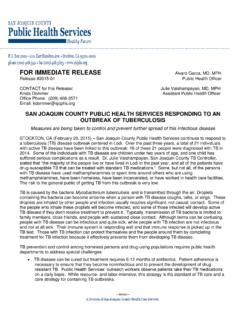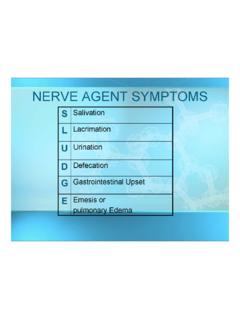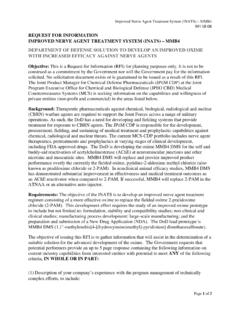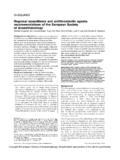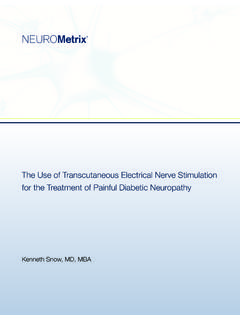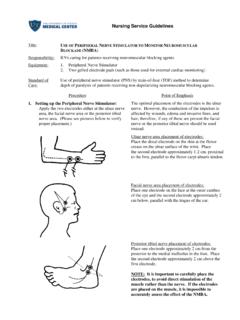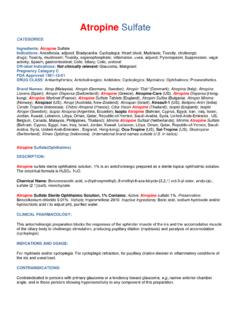Transcription of Nerve Agents - Public Health Service
1 Nerve Agents The Nerve Agents are tabun (GA), sarin (GB), soman (GD), and VX. Nerve Agents are the most toxic of all the weaponized military Agents . These Agents can cause sudden loss of consciousness, seizures, apnea, and death. Sarin (GB), one of the more commonly stockpiled Nerve Agents , may be inhaled as a vapor, or cause toxic effects by contact with the skin in the liquid form. VX is mainly a liquid skin hazard at normal ambient temperatures. These chemicals are easily absorbed through the skin, eyes, and lungs. The diagnosis of a Nerve agent poisoned casualty must be made clinically on the basis of the presenting signs and symptoms: sudden loss of consciousness, seizures, apnea, and death. There usually is not time for laboratory confirmation. Nerve Agents inhibit cholinesterase, an enzyme present in tissues and blood. There is a laboratory blood test to determine cholinesterase activity.
2 141 Characteristics The Nerve Agents belong to a class of chemicals called organophosphates and have a physiological effect similar to that of many insecticides commonly found in the community, such as malathion, diazinon, and chlorpyrifos. If organophosphate poisoning is not treated with appropriate antidote, the effect on cholinesterase is permanent. Included among the Nerve Agents are chemicals called carbamates, which include some drugs (such as physostigmine and pyridostigmine) and some insecticides (Sevin7, Raid, etc.). These compounds cause the same clinical effects as the Nerve Agents developed for military use, but the latter are more than a hundred-fold more potent. Also, with carbamates, the effect on cholinesterase is only temporary. Nerve Agents are stored and transported in the liquid state. The G- Agents such as sarin (GB), soman (GD), and tabun (GA) are volatile liquids at normal temperatures although, the most volatile, sarin, evaporates at about the same rate as water.
3 In liquid form, the G- Agents can be absorbed through the skin and eyes; vapor is absorbed by inhalation and through the eyes, but not through the skin unless the concentration of vapors is extremely high. The G- agent liquids are more effective in penetrating skin when the chemical is trapped between the skin and clothes. GB rapidly evaporates and is considered to be a non-persistent agent , meaning that it does not remain on terrain or equipment very long. VX is a persistent agent due to its low volatility. Though liquid at normal temperatures, VX has the consistency of motor oil, and seldom presents a vapor hazard, unless exploded or subjected to high temperature. VX is much more toxic (100 to 150 times) than sarin when on the skin because sarin evaporates from the skin surface while VX does not. Mechanism of Action Nerves communicate with muscles, glands, and other nerves by releasing chemicals (neurotransmitters) at their connection sites (synapses).
4 One of the most common neurotransmitters is acetylcholine (ACh), which is released and collects at the receptor site stimulating the end organ to respond and produce a variety of effects: muscle contractions, gland secretions, and Nerve to Nerve conduction. These are known as cholinergic nerves and synapses. When a Nerve impulse reaches the synapse, ACh is released from the Nerve ending and diffuses across the synaptic cleft to combine with receptor sites on the next Nerve , muscle, or gland and stimulate a response. To stop further stimulation of the Nerve , muscle, or gland, ACh is rapidly broken down by the enzyme acetylcholinesterase (AChE) located in the postsynaptic receptor region, producing choline, acetic acid, and the regenerated enzyme. Thus, a check and balance system prevents Terrorism Agents 5-11 the accumulation of ACh and the resultant over-stimulation of nerves, muscles, and glands.
5 The term Nerve agent refers to chemical that produces biological effects by inhibiting the enzyme AChE, thus allowing the neurotransmitter ACh to accumulate. As a result of inhibition of AChE, the neurotransmitter ACh accumulates and over-stimulates the receptors of the 42 cholinergic nerves and causes hyperactivity of the cholinergic nerves, muscles, and glands. Cholinergic synapses have two types of receptors: muscarinic receptors, nicotinic receptors, or a combination (central nervous system and cardiovascular system). Organs with muscarinic receptors include smooth muscles and exocrine glands; those with nicotinic sites are skeletal muscles and pre-ganglionic fibers. Muscarinic receptors Over-stimulation at muscarinic sites will increase glandular secretions. The victim may experience increased saliva, tearing, runny nose, thick secretions in the airways, and sweating; remembered by the acronym SLUDGE: salivation, lacrimation, urination, defecation and gastrointestinal emesis.
6 Smooth muscle over-stimulation Over-stimulation of smooth muscles causes pinpoint pupils (miosis), bronchoconstriction of airways (shortness of breath), and hyperactivity of the gastrointestinal tract (nausea, vomiting, and diarrhea). Nicotinic receptors Over-stimulation of nicotinic receptors causes skeletal muscle fasciculations, twitching, cramping, weakness, and finally paralysis. There is also stimulation of the pre-ganglionic fibers, which may contribute to hypertension and tachycardia. The combination of pinpoint pupils, muscle fasciculations and respiratory distress is reliable clinical evidence of organophosphate ( Nerve agent ) poisoning. Cardiovascular Cardiovascular effects that may occur are bradyarrhythmias and hypotension. Tachyarrhythmias (sinus tachycardia, ventricular tachycardia, and ventricular fibrillation), hypertension, and heart blocks may also occur.
7 Most of these cardiovascular effects disappear once the antidote is given. Central Nervous System Acute severe effects include: loss of consciousness, seizures, and apnea. Effects from a mild exposure include: nervousness, fatigue, minor memory disturbances, irritability, and other minor psychological symptoms. The latter, whether caused by a severe or mild exposure, might linger for 4 to 6 weeks after exposure before resolving. Cause of Death The cause of death in Nerve agent exposure is respiratory failure due to: bronchospasm and thick secretions in the airways; weakness of respiratory muscles to flaccid paralysis; and inhibition of the respiratory center in the CNS. 143 Clinical Effects Vapor After exposure to a small amount of vapor from a volatile Nerve agent like GB, the most common effects are miosis - often with pain in the eye or head, complaints of dim or blurred vision or conjunctival injection, rhinorrhea, and some degree of bronchoconstriction and bronchosecretions with associated complaints of a tight chest and/ or shortness of breath.
8 After exposure to a moderate amount of vapor, besides the signs and symptoms noted above, the victim will show signs of multiple system involvement - especially increasing respiratory Terrorism Agents 5-12 distress and nausea, vomiting and diarrhea After exposure to a large amount of vapor, the victim will almost immediately lose consciousness, and seizures will begin within 1 to 2 minutes. After several minutes of seizing, apnea and flaccid paralysis will occur. Effects begin within a minute or so after vapor exposure and generally do not worsen significantly once the contamination is removed. Peak effects usually occur within the first 5 minutes following exposure. If the exposure has been small and a victim is removed from the area of the exposure, shortness of breath may improve. In this situation, the removal of clothing is often adequate decontamination. Liquid Persistent Agents like VX present more of a liquid contact hazard.
9 The onset of effects following exposure can be delayed from 10 minutes to 18 hours after contact with the agent , depending on the dose. With military grade purity the LD 50 for VX is 10 mg, a droplet the size of the head of a pin. Fortunately, terrorists are unlikely to achieve such purity (the sarin at the Tokyo incident was a 20-40 % solution). small dose - A very fine droplet on the skin will cause fasciculations and diaphoresis under the droplet site. There will be no pinpoint pupils. moderate dose - With a larger droplet multiple system effects will occur including gastrointestinal (GI), nausea, vomiting, and diarrhea. Generally, there will be no pinpoint pupils. large dose - A droplet the size of the LD50 on the skin will cause sudden loss of consciousness, seizures, flaccid paralysis, and apnea within minutes. Medical Management Self-protection The process of treating Nerve agent casualties may be divided into several components.
10 The first and most important concept is to protect oneself. Although liquid contaminated casualties are unlikely to present directly to the hospital ED prior to decontamination by emergency responders, medical personnel should always protect themselves by assuming the presence of liquid contamination, unless a clear vapor only exposure history is obtained. Whenever possible, areas of liquid contamination should be decontaminated prior to patient handling to minimize spread of contamination and cross contamination of other providers. Decontamination In the immediate aftermath of the sarin Nerve agent attack in Tokyo, over 650 patients presented to St. Luke s Hospital within several hours after the release of sarin. With high numbers of vapor-exposed patients presenting to a medical facility under these conditions, minimum decontamination should include removal of patients clothing and jewelry.



